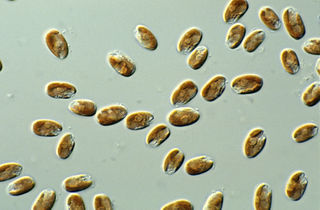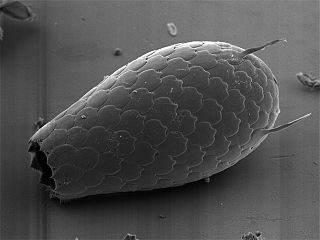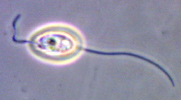Related Research Articles

Cryptophyta is a group of single-celled flagellates. It contains a small group of heterotrophic flagellates known as katablepharids, as well as the abundant cryptomonads, which comprise the heterotrophic Goniomonadea and the photosynthetic Cryptophyceae. It is considered a division of algae among phycologists. It is alternatively known as Rollomonadia. Together with Palpitomonas and the Endohelea heliozoans, they compose the phylum Cryptista.
Hatena arenicola is a species of single-celled eukaryotes discovered in 2000, and first reported in 2005. It was discovered by Japanese biologists Noriko Okamoto and Isao Inouye at the University of Tsukuba, and they gave the scientific description and formal name in 2006. The species is a flagellate, and can resemble a plant at one stage of its life, in which it carries a photosynthesizing alga inside itself, or an animal, acting as predator in another stage of its life. Researchers believe that this organism is in the process of secondary endosymbiosis, in which one organism is incorporated into another, resulting in a completely new life form.
Leucocryptos is a genus of single-celled eukaryotes comprising one to two species.
Anaeromonadea, also known as Preaxostyla, is a class of excavate protists, comprising the oxymonads, Trimastix, and Paratrimastix. This group is studied as a model system for reductive evolution of mitochondria, because it includes both organisms with anaerobic mitochondrion-like organelles, and those that have completely lost their mitochondria.

Thaumatomonadida is an order of flagellates.

Bigyra is a phylum of microscopic eukaryotes that are found at the base of the Stramenopiles clade. It includes three well-known heterotrophic groups Bicosoecida, Opalinata and Labyrinthulomycetes, as well as several small clades initially discovered through environmental DNA samples: Nanomonadea, Placididea, Opalomonadea and Eogyrea. The classification of Bigyra has changed several times since its origin, and its monophyly remains unresolved.

The sarcomonads or class Sarcomonadea are a group of amoeboid biciliate protists in the phylum Cercozoa. They are characterized by a propensity to move through gliding on their posterior cilium or through filopodia, a lack of scales or external theca, a soft cell surface without obvious cortical filamentous or membranous skeleton, two cilia without scales or hairs, tubular mitochondrial cristae, near-spherical extrusomes, and a microbody attached to the nucleus.
Proleptomonas is a genus of coprophilic protists, containing the single species Proleptomonas faecicola. It belongs to the phylum Cercozoa, although it was previously considered the only free-living kinetoplastid. It is the only member of family Proleptomonadidae.
Falcomonas is a genus of cryptophytes placed in the family Chroomonadaceae.

Hemiselmis is a genus of cryptomonads.

The kathablepharids are a group of heterotrophic flagellates (Protists) the first species of which was described by Skuja in 1939 as Kathablepharis phoenikoston. His spelling was challenged because of non-compliance with botanical nomenclatural conditions, hence the alternative spelling Katablepharis. As the organism was heterotrophic and usually regarded as 'protozoan', and to favour stability, Skuja's original spelling has largely prevailed. With an anterior pocket and ejectisomes, the kathablepharids were thought initially to be cryptomonads. There were a variety of differences with Cryptomonas and other typical cryptomonads = cryptophytes, such as the thickness, length, and beat pattern of the flagella, their phagotrophic habitat, differences in the ejectisomes, and various features of their ultrastructure. The distinctive characteristics of the group were established from electron microscopical studies by Clay and Kugrens and Vørs. More recently they have been tentatively grouped with the chromalveolates, or distantly with the cryptophytes.
Diphylleia rotans is a eukaryotic microorganism. It is notable for having a gene-rich mitochondrial genome, the largest known outside the jakobids.

Diplonemidae is a family of biflagellated unicellular protists that may be among the more diverse and common groups of planktonic organisms in the ocean. Although this family is currently made up of three named genera; Diplonema, Rhynchopus, and Hemistasia, there likely exist thousands of still unnamed genera. Organisms are generally colourless and oblong in shape, with two flagella emerging from a subapical pocket. They possess a large mitochondrial genome composed of fragmented linear DNA. These non-coding sequences must be massively trans-spliced, making it one of the most complicated post-transcriptional editing process known to eukaryotes.

Cryptista is a clade of alga-like eukaryotes. It is most likely related to Archaeplastida which includes plants and many algae, within the larger group Diaphoretickes.
The paracercomonads are a group of cercozoan protists. Taxonomically, they comprise the family Paracercomonadidae, order Paracercomonadida and subclass Paracercomonada. Due to their morphological similarities to the cercomonads, members of this family were grouped with Cercomonas and similar taxa from the beginning. However, their similarities are due to convergent evolution.

Ventrifilosa is a highly diverse group of phagotrophic protists that glide through their flagella and emit filose pseudopods from their ventral side for feeding. Because of their mixture of amoeba and flagellate characteristics, they are amoeboflagellates. Members of this group are the Imbricatea, Sarcomonadea and Thecofilosea.
Pediglissa is a subclass of phagotrophic protists that inhabit soil or freshwater habitats. They were defined in 2018 according to phylogenetic analyses that showed a clade containing the orders Cercomonadida and Glissomonadida. They're the sister group of Paracercomonadida.

Urceolus is a genus of heterotrophic flagellates belonging to the Euglenozoa, a phylum of single-celled eukaryotes or protists. Described by Russian biologist Konstantin Mereschkowsky in 1877, its type species is Urceolus alenizini. Species of this genus are characterized by deformable flask-shaped cells that exhibit at least one flagellum that is active at the tip, arising from a neck-like structure that also hosts the feeding apparatus. They are found in a variety of water body sediments across the globe. According to evolutionary studies, Urceolus belongs to a group of Euglenozoa known as peranemids, closely related to the euglenophyte algae.
Paratrimastix is a genus of free-living freshwater anaerobic excavate protists from the group Metamonada, that was segregated from the genus Trimastix in 2015. The best studied species is Paratrimastix pyriformis.

Ploeotia is a genus of heterotrophic flagellates belonging to the Euglenida, a diverse group of flagellated protists in the phylum Euglenozoa. Species of Ploeotia are composed of rigid cells exhibiting two flagella. The genus was described by Félix Dujardin in 1841.
References
- 1 2 "Katablepharids".
- 1 2 3 Clay, B; Kugrens, P (Mar 1999). "Systematics of the enigmatic kathablepharids, including EM characterization of the type species, Katablepharis phoenikoston, and new observations on K. remigera comb.nov". Protist. 150 (1): 43–59. doi:10.1016/S1434-4610(99)70008-8. ISSN 1434-4610. PMID 10724518.
- 1 2 3 Robert Edward Lee; Paul Kugrens (Dec 1992). "Relationship between the flagellates and the ciliates". Microbiological Reviews. 56 (4): 529–542. doi:10.1128/mr.56.4.529-542.1992. PMC 372886 . PMID 1480107.
- ↑ Okamoto, N; Inouye, I (Aug 2005). "The katablepharids are a distant sister group of the Cryptophyta: A proposal for Katablepharidophyta divisio nova/ Kathablepharida phylum novum based on SSU rDNA and beta-tubulin phylogeny". Protist. 156 (2): 163–79. doi: 10.1016/j.protis.2004.12.003 . ISSN 1434-4610. PMID 16171184.
- ↑ Lee, Robert Edward; Kugrens, Paul (1991). "Katablepharis Ovalis, A Colorless Flagellate with Interesting Cytological Characteristics1". Journal of Phycology. 27 (4): 505–513. doi:10.1111/j.0022-3646.1991.00505.x. S2CID 86184221.